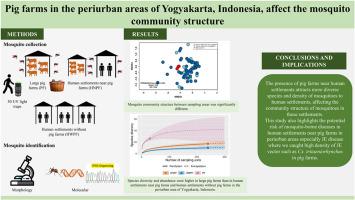Impact of peri-urban pig farms on mosquito community structure in Yogyakarta, Indonesia
IF 1.7
Q3 PARASITOLOGY
Current research in parasitology & vector-borne diseases
Pub Date : 2025-01-01
DOI:10.1016/j.crpvbd.2025.100310
引用次数: 0
Abstract
Livestock-keeping in peri-urban areas might influence mosquito-borne diseases by attracting more mosquitoes or by diverting mosquitoes from feeding on humans. In this study, we compared the mosquito community structure across pig farms, human settlements around pig farms, and human settlements without pig farms in peri-urban areas of Yogyakarta. We collected mosquitoes using ultraviolet light traps from three large pig farms (10 traps), 120 human settlements near pig farms (20 traps), and 120 human settlements without pig farms (20 traps) in Yogyakarta. The adult mosquitoes were morphologically identified using taxonomic keys. Polymerase chain reaction was used only to identify damaged and unidentified mosquito specimens using the cytochrome c oxidase subunit 1 gene marker. A total of 2253 adult mosquitoes (1663 females and 590 males) belonging to 26 species were collected from large pig farms, human settlements near pig farms, and human settlements without pig farms. Permutational multivariate analysis of variance revealed significant differences in mosquito community structure between the three areas (R2 = 0.66, P = 0.001). Large pig farms had higher mosquito diversity (26 species) than human settlements near pig farms (17 species) and human settlements without pig farms (10 species), with the highest number of Japanese encephalitis vector, Culex tritaeniorhynchus (381 individuals) collected in large pig farms and some zoophilic mosquitoes (e.g. Anopheles vagus, An. aconitus, An. barbirostris, Mansonia uniformis, Mn. annulata, Cx. tritaeniorhynchus, Cx. hutchinsoni, and Mimomyia luzonensis) found in human settlements near pig farms. Artificial containers for animal drinking were found to be breeding sites for Aedes aegypti, Ae. albopictus, and Culex quinquefasciatus in large pig farms. Raising pigs near human settlements increases the diversity and density of mosquito species, as demonstrated in our study, which also identifies pig farms as potential breeding sites for mosquitoes and highlights the higher risk of emergence of mosquito-borne diseases. Our data highlight the increased risk of Japanese encephalitis (JE) transmission in areas near pig farms and suggest that livestock relocation from human settlements and management practices to control mosquito breeding sites in pig farms in peri-urban areas could reduce the risk of disease outbreaks.

印度尼西亚日惹市城郊养猪场对蚊子群落结构的影响
城郊地区的牲畜饲养可能会吸引更多的蚊子,或使蚊子不再以人类为食,从而影响蚊子传播的疾病。在本研究中,我们比较了日惹城郊猪场、猪场周围人类住区和无猪场的人类住区的蚊子群落结构。我们在日惹市的3个大型猪场(10个)、猪场附近的120个人类住区(20个)和120个无猪场的人类住区(20个)使用紫外线诱捕器收集蚊子。利用分类键对成蚊进行形态鉴定。利用细胞色素c氧化酶亚基1基因标记,聚合酶链反应仅用于鉴定受损和未鉴定的蚊子标本。在大型猪场、猪场附近人居环境和无猪场人居环境共捕获成蚊26种2253只,雌蚊1663只,雄蚊590只。多因素方差分析显示,3个地区蚊虫群落结构差异显著(R2 = 0.66, P = 0.001)。大型猪场的蚊子多样性(26种)高于靠近猪场的人类住区(17种)和无猪场的人类住区(10种),其中日本脑炎病媒三带喙库蚊(381只)在大型猪场采集最多,迷走按蚊、安。aconitus,。barbirostris, Mansonia uniformis, Mnannulata,残雪。tritaeniorhynchus,残雪。在猪场附近的人类住区中发现了哈钦索菌(hutchinsoni)和吕宋Mimomyia luzonensis。动物饮水用人工容器是埃及伊蚊、伊蚊、白纹伊蚊的孳生场所。大型养猪场发现白纹伊蚊和致倦库蚊。正如我们的研究所表明的那样,在人类住区附近养猪增加了蚊子种类的多样性和密度,这也确定了猪场是蚊子的潜在滋生地,并强调了蚊子传播疾病出现的更高风险。我们的数据强调了日本脑炎(乙脑)在猪场附近地区传播的风险增加,并建议将牲畜从人类住区转移和控制城郊猪场蚊子滋生地的管理措施可以降低疾病暴发的风险。
本文章由计算机程序翻译,如有差异,请以英文原文为准。
求助全文
约1分钟内获得全文
求助全文

 求助内容:
求助内容: 应助结果提醒方式:
应助结果提醒方式:


